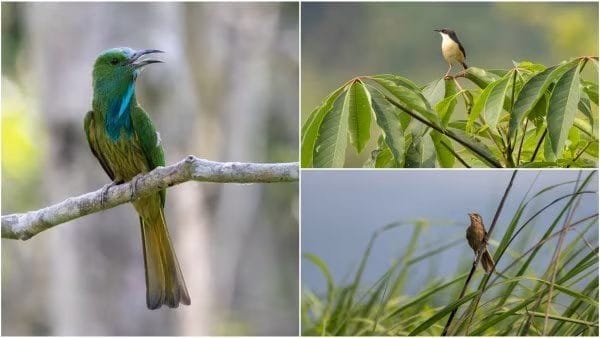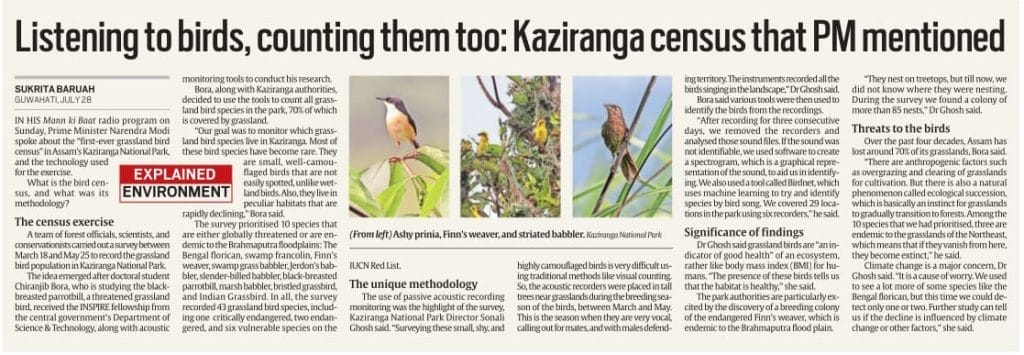

Why in news:
Prime Minister Narendra Modi applauded the first grassland bird census of India in Kaziranga during his “Mann Ki Baat” program, highlighting the successful fusion of human effort, technology, and sensitivity in nature conservation.
UPSC CSE Relevance:
UPSC CSE in prelims examination has focused on Species in news every year and population census. UPSC asked at least one question related to species. A case in point is a following PYQ.
Q: Consider the following statements:
1.Some species of turtles are herbivores.
2.Some species of fish are herbivores.
3.Some species of marine mammals are herbivores.
4.Some species of snakes are viviparous.
Which of the statements given above are correct?
A) 1 and 3 only
B) 2, 3 and 4 only
C) 2 and 4 only
D) 1, 2, 3 and 4
First Grassland Bird Census:
- It is the first time a dedicated grassland bird census has been carried out in Kaziranga National Park, shifting focus beyond its famous megafauna (rhinos, tigers, elephants) to highlight its crucial avian diversity.
- More than 60% of the park is grasslands with grasses like elephant grass.
- The census was a collaborative endeavor involving forest officials, scientists, and leading Indian ornithologists from organizations like Aaranyak, WII, and WWF-India.
- The survey was conducted from March 18 to May 25, 2025. It spanned 185 grassland sites across the Eastern Assam, Biswanath, and Nagaon Wildlife Divisions of KNPTR, covering a significant portion of its floodplain grasslands.
Key Findings:
- It recorded a total of 43 grassland bird species. This highlights Kaziranga as a major site for grassland bird diversity in India, comparable to the dry grasslands of Gujarat and Rajasthan.
- The 43 species identified include one Critically Endangered, two Endangered, and six Vulnerable species as per the IUCN Red List.
- Critically Endangered: Bengal Florican
- Endangered: Finn’s Weaver (locally known as ‘tukura sorai’) and Swamp Grass Babbler
- Vulnerable: Species like Swamp Francolin, Jerdon’s Babbler, Slender-billed Babbler, Black-breasted Parrotbill, Marsh Babbler, and Bristled Grassbird.
- A significant discovery was the documentation of a breeding colony of the endangered Finn’s Weaver in the Kohora Range of Kaziranga.
- This bird is considered a “master nest-builder” and a vital ecological indicator of grassland health, its presence denoting intact and functioning grassland ecosystems.
- It is endemic to Brahmaputra Flood Plains.
- They nest on tree tops generally.
Methodology:
The census employed a combination of traditional point count surveys and cutting-edge passive acoustic monitoring.
- Artificial Intelligence (AI) Analysis: The recorded bird calls were then analyzed using AI tools to accurately identify species without disturbing them. This non-invasive method significantly improved the detection of shy and cryptic birds, enhancing the accuracy and depth of the findings.
- Passive Acoustic Monitoring: Sound recording devices were installed in various grassland habitats, including remote or hard-to-access areas. These devices captured bird calls around the clock.
Significance for Conservation:
- Assam has lost 70% of its grasslands due to anthropogenic factors like overgrazing and cultivation and natural ecological succession threatening these birds.
- The survey not only provides critical data for the long-term conservation of grassland birds, which are often under-researched compared to forest and wetland species, but also reaffirms Kaziranga’s importance not just for megafauna, but also as a vital refuge for diverse avian biodiversity within the Indo-Burma biodiversity hotspot.
- The methodology used is seen as a model for integrating scientific research into protected area management, applicable to other landscapes in India.

